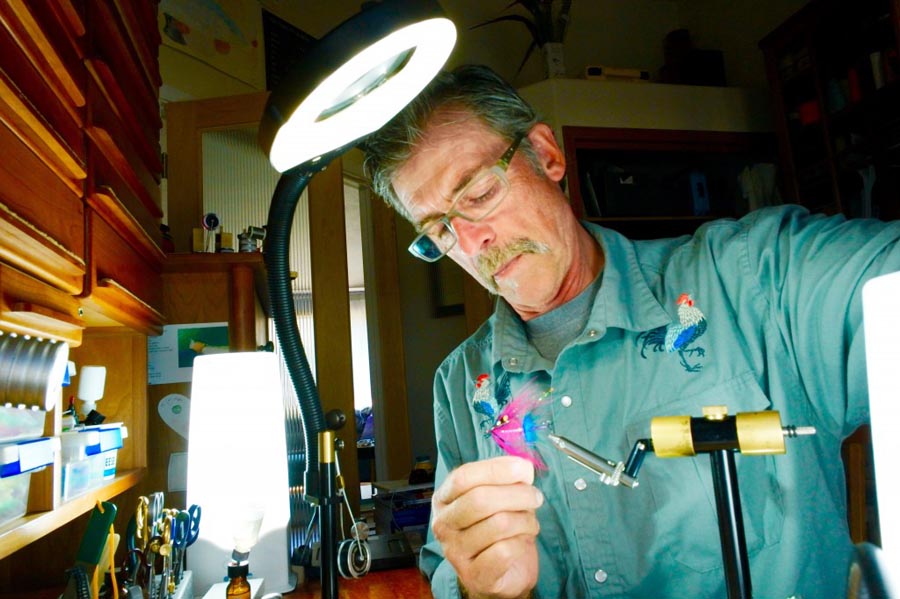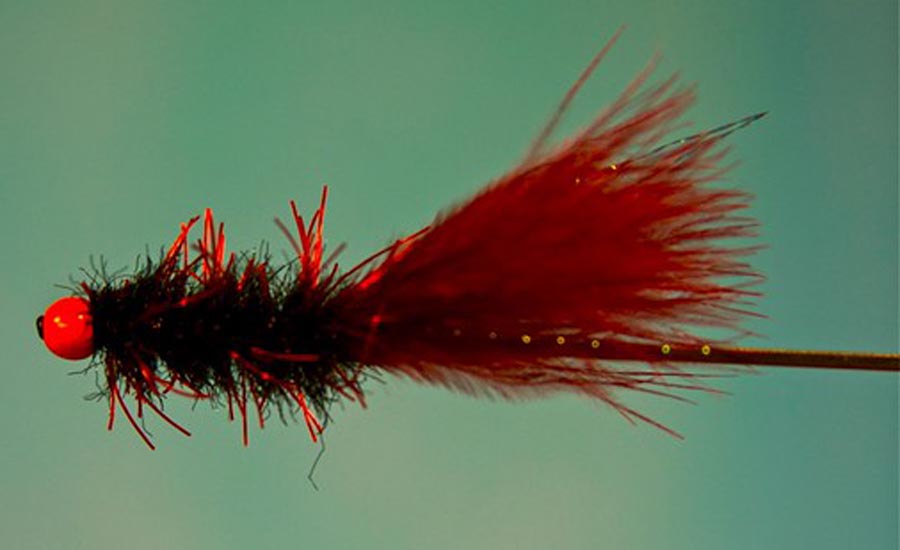
Photo Jay Nicholas/Caddis Fly Shop.
By Skip Clement

New Zealand
Jay Nicholas, imperator of The Caddis Fly Shop, Eugene, Oregon, is also the primary tyer in the Pacific Northwest that steps beyond using tube flies solely for steelhead. Jay has been behind tube flies for over a decade, and his revolutionary thinking is leading to new tying techniques for tube flies for any size pattern.
Scandinavians and increasingly almost all of Europe’s angling community, as well as Nichols, finds that tube flies can, almost always, out-attract bites versus hook-tied flies.
At the Atlanta Fly Fishing Show (February 2, 3, 4), I made it my job to interview as many Southeast regional anglers as possible (Alabama, Arkansas, Florida, Georgia, Kentucky, Louisiana, Maryland, Mississippi, North Carolina, South Carolina, Tennessee, Virginia, and West, Virginia) to determine the popularity of tube flies – specifically, that a tube fly would work on crappy and other panfish as well as on larger animals (tarpon, stripers, basses, bonefish, trout, billfish, salmon, and others). Only two had experience with tube flies (offshore for sailfish in Guatemala). Non tied tube flies and I was only able to get responders from GA, AL, NC, TN, and FL. Non had any experience with tube flies for trouts or crappie.

Jay Nicholas circa 2015.
Remarkably, professional guides, conventional anglers and fly fishers were shown dozens of game fish they were familiar with (largemouth bass, smallmouth bass, snook, tarpon, sailfish, striper bass) displaying tube fly ‘hooks’ only anchored in their lower jaw.
After seeing the images of game fish they were familiar with all anchored on a single hook most immediately said, “Where is the fly?” Do you know?
All interviewees were asked if they’d tried using tube flies. The universal answer was “NO.”
Jay said, “The fly of choice out here is a tube fly and tyers are having fun trying their hand at adapting standard patterns to tubes and using new materials. Will these catch fish? Absolutely. We have fished enough flies, all sorts, over our collective years to know that these will be effective, and gosh, it makes for fun when we sit down to tie.
The long-bodied bead-head bugger is a fly style typically crafted on 2XL, 3XL, or even 4XL shank hooks in sizes as large as #2, depending on where one is fishing.
The fly demonstrated here would be about equivalent to a bugger tied on a #8, 2XL hook, and this particular size works nicely on the small diameter classic tube, noted below.
Imagine this fly tied with a little collar of Senyo’s hot pink Laser Yarn at the head.
That would be a slow-sinking winner, too.
And could this tube bugger substitute for a hot-bead Stonefly nymph? It could, yes indeed.”

This is tied with a tungsten bead head, and man-oh-man will go down and impart that jigging action. One could also tie this fly with a standard brass, glass, or no bead at all. This bugger is an improvisation of Russell Blessing’s famous fly, The Woolly Bugger.
Tie this ‘bugger’ tube fly
Key materials of this EP Tarantula Tube Trout Bugger are noted as follows:
Thread – Veevus 6/0 or 8/0 black
Hook – Daiichi Short Shank Straight Eye D1640 #4 to #8
Tube Mandrel – Small Pro Sportfisher Flexi Needle
Tube – Small Classic Pro Sportfisher Tube, black or clear
Hook Guide – Pro Sportfisher small, black or red
Tail – Hareline Claret Wooly Bugger Marabou
Tail Flash – Krystal Flash, Pearl or Chartreuse
Body – EP Tarantula Hairy Legs Brush, ½” width, red/black
Bead – Hareline Tungsten Hot Bead 7/32
Wire Cutters – Dr. Slick 4.75” Gold Barb Crusher Scissor Clamp
Caddis Fly Shop contact:
Jay Nicholas, Caddis Fly Angling Shop
Address: 168 W 6th Ave, Eugene, OR 97401
Hours: Sunday 10 AM–3 PM Monday 10 AM–5 PM Tuesday 10 AM–5 PM Wednesday 10 AM–5 PM Thursday 10 AM–5 PM Friday 10 AM–5 PM Saturday 10 AM–5 PM
Phone: (541) 342-7005
Order: caddisflyshop.com

